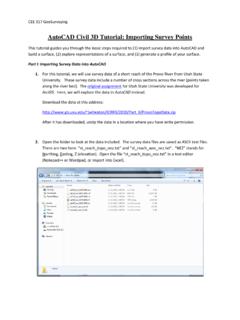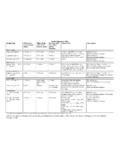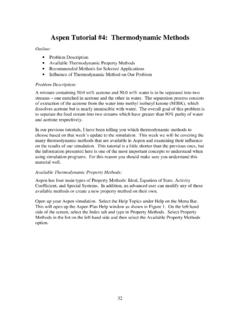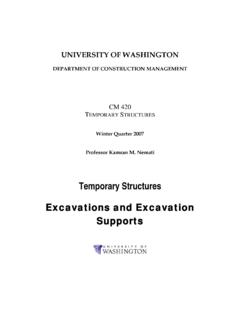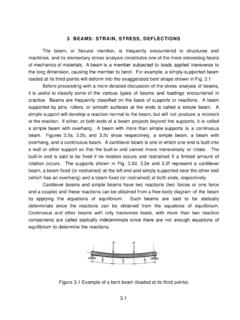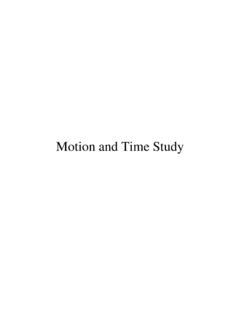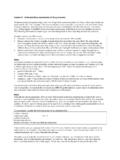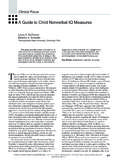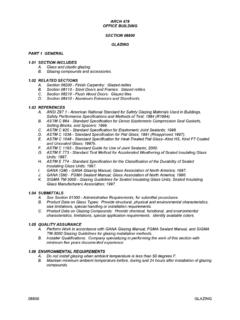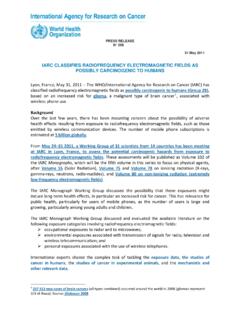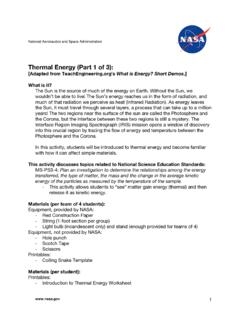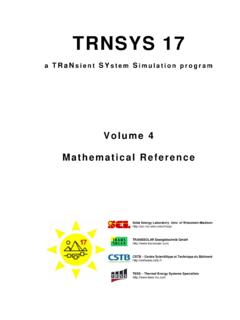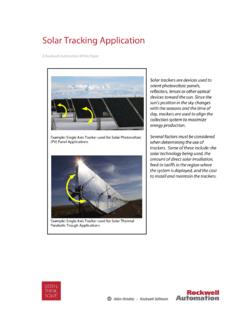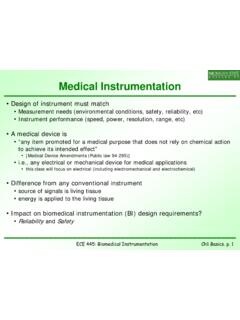Transcription of Atmospheric Air Pollutant Dispersion
1 Atmospheric Air Pollutant Dispersion Estimate air Pollutant concentrations downwind of emission point sources. Downwind Air Pollution Concentrations Are a function of: Atmospheric Stability Air Temperature Lapse Rates Atmospheric Air Inversions Atmospheric Mixing Height Dispersion from Point Emission Sources Dispersion Coefficients In CEE490/ENVH 461 class we will Primarily use EPA SCREEN software Atmospheric Air Vertical Stability Dry Adiabatic Temp T K o = = = =. Lapse Rate Altitude Z 1000 meters 1000 ft Adiabatic vertical air movement causes a change in pressure and temperature: dT/dz = g/Cp = d (dry adiabatic lapse rate). d = K/km --Stable lapse rate: < d Unstable lapse rate: > d Atmospheric Stability Characterized by vertical temperature gradients (Lapse Rates). Dry adiabatic lapse rate ( ) = oC/100 m ~.
2 1 oC/100 m International standard lapse rate = oC/m Does the air temperature lapse rate have anything to do with air quality? Yes, because it is related to amount of vertical mixing of emitted air pollutants. First Law of Thermodynamics = 0 for adiabatic expansion 1. dq = dh dP = C p dT dP.. Barometric Equation dP. = g dZ. 1. C p dT = dP = gdZ.. dT g = . dZ Cp Lapse Rate Air Temperature Lapse Rates Dry Adiabatic Lapse Rate 100 m Sub adia n io rs batic ve In Elevation Sup (m) erad iaba tic T. Temperature (oC). Stability Conditions Adiabatic lapse rate Actual Air Temperature lapse rate Diurnal Cycle of Surface Heating /Cooling z Subsidence inversion MIDDAY. 1 km Mixing depth NIGHT. 0 MORNING. T NIGHT MORNING AFTERNOON. Actual Temperature Sounding Superadiabatic Lapse Rates (Unstable air).
3 Temperature decreases are greater than -10o C/1000 meters Occur on sunny days Characterized by intense vertical mixing Excellent Dispersion conditions Atmospheric Stability Superadiabatic Strong Lapse Rate Unstable Conditions Neutral Air Temp Lapse Rates Temperature decrease with altitude is similar to the adiabatic lapse rate Results from: Cloudy conditions Elevated wind speeds Day/night transitions Describes OK Dispersion conditions Isothermal Lapse Rates (Weakly Stable). Characterized by no temperature change with height Atmosphere is somewhat stable Dispersion conditions are moderate Atmospheric Stability Subadiabatic Weak Lapse Rate Stable Conditions 2 major types of inversion: Subsidence: descent of a layer of air within a high pressure air mass (descending air increases pressure & temp.)
4 radiation : thermal radiation at night from the earth's surface into the clear night sky radiation Inversion Inverted Air Temp Lapse Rates (Strongly Stable). Characterized by increasing air temperature with height Does it occur during the day or at night? (Both). Is it associated with high or low air pressure systems? (High). Does it improve or deteriorate air quality? (deteriorate). Inversion Inversion: Air Temperature increases with altitude (web).jpg radiation Inversions Result from radiational cooling of the ground Occur on cloudless nights and clear sky nocturnal Are intensified in valleys (heavier cooled air descends to valley floor). Cause air pollutants to be trapped (poor vertical transport). What happens to inversion when sun rises? radiation Inversions Inversion Breaks up after sunrise Breakup results in elevated ground level concentrations Breakup described as a fumigation Red Line is Air Temperature Blue Line is adiabatic air temp lapse radiation Inversions Elevated inversions are formed over urban areas Due to heat island effect Subsidence Inversion Associated with Atmospheric high-pressure systems Inversion layer is formed aloft due to subsiding air Persists for days Subsidence Inversion Migrating high-pressure systems.
5 Contribute to the hazy summer conditions Semi-permanent marine high-pressure systems Results in a large number of sunny calm days Inversion layer closest to the ground on continental side Responsible for air stagnation over Southern California Advective - warm air flows over a cold surface Mixing Height = Height of air that is mixed and where Dispersion occurs What is the Mixing Height in a radiational inversion? When does the max MH occur during a day? Min MH? Which season has the max MH? Min MH? Why does Phoenix have a larger MH than New Orleans? Why is agricultural burning allowed only during daytime? Air Pollutant Dispersion from Point Sources Plume rise affects Dispersion and transport Affects maximum ground level concentrations Affects distance to maximum ground level conc.
6 Lapse Rates and Atmospheric Stability Weak Lapse Condition (Coning). Wind Z = altitude T = Temp = adiabatic lapse rate Stack Plume: Coning Strong wind, no turbulence What is the stability class? (dashed line is adiabatic lapse rate) C. Is there good vertical mixing? OK. On sunny or cloudy days? Partly cloudy Good for dispersing pollutants? OK. Lapse Rates and Atmospheric Stability Inversion Condition (Fanning). Wind Stack Plume: Fanning ~npoor/4. What is the stability class? (solid line is actual air temperature with altitude air temp lapse rate). What is the top view of the plume? Stack Plume: Fumigation Why can't the pollutants be dispersed upward? Plume trapped by inversion above stack height. Does it happen during the day or night? Morning Lapse Rates and Atmospheric Stability Inversion Below, Lapse Aloft (Lofting).
7 Wind Stack Plume: Lofting Why can't the pollutants be dispersed downward? What time of the day or night does this happen? Evening night as radiation inversion forms Lapse Rates and Atmospheric Stability Weak Lapse Below, Inversion Aloft (Trapping). Wind Stack Plume: Trapping What weather conditions cause plume trapping? radiation inversion at ground level, subsidence inversion at higher altitude (evening night). Stack Plume: Looping Strong turbulence ~npoor/3. Is it at stable or unstable condition? Unstable High or low wind speed? Low wind speed. Does it happen during the day or night? Day Is it good for dispersing pollutants? Yes Dilution of Pollutants in the Atmosphere Air movement can dilute and remove pollutants (removal by absorption and deposition by snow, rain, & to surfaces).
8 Pollutant dilution is variable, from quite good to quite poor, according to the wind velocity and the air stability (lapse rate). Characteristics of Dispersion Models The accuracy of air Pollutant Dispersion models varies according to the complexity of the terrain and the availability of historic meteorological data . The acceptability of the results of Dispersion models varies with the experience and viewpoint of the modeler, the regulator and the intervener. Air Quality Modeling Gaussian Dispersion Model EPA Air Quality Models (SCREEN TSCREEN,ISC, AERMOD, etc.). are computer software with equation parameters that include Pollutant emission rate Q (gms/sec), stack height (meters), stack inside diameter at exit, stack gas temp, stack gas exit velocity (m/s) ambient air temp, receptor height (m), topography, etc.
9 And calculate the downwind air Pollutant concentrations. The EPA Dispersion software models are used to: 1. Evaluate compliance with NAAQS & prevention of significant air quality deterioration (PSD required for permit to construct). 2. Find Pollutant emission reductions required. 3. Review permit to construct applications. Is the Air Quality OK? What is the level of my exposure to these emissions? Is my family safe? Where is a safe location with regards to air quality? How about the adverse impact on the environment (plants, animals, buildings)? How to predict the impact of air Pollutant emissions resulting from population growth? Where is the cleanest air; in city center, in rural area? Note: Children health (respiratory effects) has been correlated to the distance from their home to nearest highway or busy street (diesel engine emissions).
10 When are model applications required for regulatory purposes? SCREEN3, TSCREEN, ISC (Industrial Source Complex), AERMOD. AERMOD stands for American Meteorological Society Environmental Protection Agency Regulatory Model Formally Proposed as replacement for ISC in 2000. Adopted as Preferred Model November 9, 2005. Regulatory Application of Models PSD: Prevention of Significant Deterioration of Air Quality in relatively clean areas ( National Parks, Wilderness Areas, Indian Reservations). SIP: State Implementation Plan revisions for existing sources and for New Source Reviews (NSR). Classifications of Air Quality Models Developed for a number of air Pollutant types and time periods Short-term models for a few hours to a few days; worst case episode conditions Long-term models to predict seasonal or annual average concentrations; health effects due to exposure Classified by Non-reactive models pollutants such as SO2 and CO.
